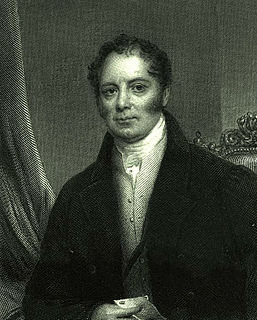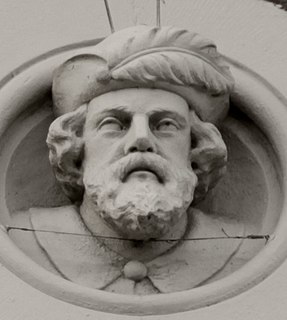
Edward Baines (1774–1848) was the editor and proprietor of the Leeds Mercury,, politician, and author of historical and geographic works of reference. On his death in 1848, the Leeds Intelligencer described his as "one who has earned for himself an indisputable title to be numbered among the notable men of Leeds".
The Yorkshire Post is a daily broadsheet newspaper, published in Leeds in Northern England. It primarily covers stories from Yorkshire although its masthead carries the slogan "Yorkshire's National Newspaper". It was previously owned by Johnston Press and is now owned by JPIMedia. Founded in 1754, it is one of the oldest newspapers in the country.
Yorkshire Post Newspapers are publishers of the Yorkshire Post and Yorkshire Evening Post. They were based at offices in Wellington Street, but in November 2012 they moved to Number 1 Leeds, Whitehall Road, where they took four floors in the managed building Leeds, West Yorkshire. They are ultimately owned by JPIMedia.

Knaresborough railway station is a Grade II listed station serving the town of Knaresborough in North Yorkshire, England. It is located on the Harrogate Line 16.75 miles (27 km) west of York and is operated by Northern Trains, who provide all passenger train services.

The Northern Star and Leeds General Advertiser was a chartist newspaper published in Britain between 1837 and 1852, and best known for advancing the reform issues articulated by proprietor Feargus O'Connor.

Talbot Baines Reed was an English writer of boys' fiction who established a genre of school stories that endured into the mid-20th century. Among his best-known work is The Fifth Form at St. Dominic's. He was a regular and prolific contributor to The Boy's Own Paper (B.O.P.), in which most of his fiction first appeared. Through his family's business, Reed became a prominent typefounder, and wrote a standard work on the subject: History of the Old English Letter Foundries.

Leeds was a parliamentary borough covering the town of Leeds, in the West Riding of Yorkshire, England. It was represented in the House of Commons of the Parliament of the United Kingdom from 1832 to 1885.
The newspapers of Yorkshire have a long history, stretching back to the 18th century. Regional newspapers have enjoyed varying fortunes, reflected in the large number of now-defunct papers from Yorkshire.

Sir Edward Baines, also known as Edward Baines Jr, was a nonconformist English newspaper editor and Member of Parliament (MP).
Maurice Warwick Beresford, was an English economic historian and archaeologist specialising in the medieval period. He was Professor of Economic History at the University of Leeds.
The Leeds Intelligencer or Leedes Intelligencer was one of the first regional newspapers in Great Britain. It was founded in Leeds, West Riding of Yorkshire, England, in 1754 and first published on 2 July 1754. It was a weekly paper until it was renamed and became the daily Yorkshire Post, first published on Monday 2 July 1866. It was published under the motto of The Altar, the Throne and the Cottage and was, from the outset, a conservative newspaper. It dropped the extra 'e' from the name Leedes in 1765 and was recognized as being anti-Catholic and being opposed to Chartism.
William Beckett-Denison was an English banker and Conservative Party politician who sat in the House of Commons in two periods between 1876 and 1890. He died when he fell under a train.
Thomas Baines (1806–1881), was an English journalist and historian.
The Board of Inland Revenue Stamping Department Archive in the British Library contains artefacts from 1710 onwards, and has come into existence through amendments in United Kingdom legislation.

Ripon railway station was a railway station that served Ripon, North Yorkshire, England on the Leeds-Northallerton Line that ran between Harrogate and Northallerton.
Katrina Honeyman was a British economic historian and Professor of Social and Economic History at the University of Leeds. Much of her work focused on the role of women and children in industrialisation in Britain.
Henry John Athelson Scott was founding editor of the Dalesman magazine, in Yorkshire, northern England. He established the journal, originally called The Yorkshire Dalesman, from the front room of his cottage in Clapham, North Yorkshire, in 1939. He remained editor, then managing director, of The Dalesman and sister magazine Cumbria until his death in 1978, aged 76. In the meantime The Dalesman grew to become Britain's best-selling regional magazine. Scott was also an early BBC royal correspondent. During the late 1930s he described a number of royal visits to the north of England for broadcast on the BBC's Northern Programme. Later in his career he wrote a number of books about his beloved Yorkshire and his business became a prolific publisher of books in the North of England.

John Wormald Appleyard was a sculptor and monumental mason based in Leeds, West Yorkshire, England.

Joseph Hubert Priestley was a British lecturer in botany at University College, Bristol, and professor of botany and pro-vice-chancellor at the University of Leeds. He has been described as a gifted teacher who attracted many graduate research students to Leeds. He was the eldest child of a Tewkesbury head teacher and the elder brother of Raymond Priestley, the British geologist and Antarctic explorer. He was educated at his father's school and University College, Bristol. In 1904, he was appointed a lecturer in botany at the University College and published research on photosynthesis and the effect of electricity on plants. He was elected a fellow of the Linnean Society, and in 1910, he was appointed consulting botanist to the Bath and West and Southern Counties Society.








